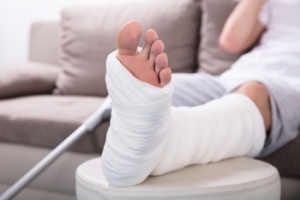Connect With Us

Tips to Prevent Fungal Toenail Infections
 Fungal nail infections often form when fungi gets into small cracks on the toenails. These infections cause the nail to turn brown or yellow and become thick and crumbly. The fungi that leads to nail infections often thrive in warm and moist environments such as locker rooms, showers, and pool areas. Because of this, it is important to always wear some form of footwear in these environments. Other common ways to prevent toenail infections include frequently washing the feet, not sharing clippers or nail files, wearing a fresh pair of socks daily, wearing breathable footwear, and not sharing footwear with others. When fungal nail infections are left untreated, they can become painful and foul smelling. Therefore, if you do believe that you may have a fungal nail infection, it is important to consult with a podiatrist for treatment options.
Fungal nail infections often form when fungi gets into small cracks on the toenails. These infections cause the nail to turn brown or yellow and become thick and crumbly. The fungi that leads to nail infections often thrive in warm and moist environments such as locker rooms, showers, and pool areas. Because of this, it is important to always wear some form of footwear in these environments. Other common ways to prevent toenail infections include frequently washing the feet, not sharing clippers or nail files, wearing a fresh pair of socks daily, wearing breathable footwear, and not sharing footwear with others. When fungal nail infections are left untreated, they can become painful and foul smelling. Therefore, if you do believe that you may have a fungal nail infection, it is important to consult with a podiatrist for treatment options.
For more information about treatment, contact Leonard Talarico, DPM of Georgia. Our doctor can provide the care you need to keep you pain-free and on your feet.
Toenail Fungus Treatment
Toenail fungus is a condition that affects many people and can be especially hard to get rid of. Fortunately, there are several methods to go about treating and avoiding it.
Antifungals & Deterrence
Oral antifungal medicine has been shown to be effective in many cases. It is important to consult with a podiatrist to determine the proper regiment for you, or potentially explore other options.
Applying foot powder on the feet and shoes helps keep the feet free of moisture and sweat.
Sandals or open toed shoes – Wearing these will allow air movement and help keep feet dry. They also expose your feet to light, which fungus cannot tolerate. Socks with moisture wicking material also help as well.
If you have any questions please feel free to contact our office located in Pooler, GA . We offer the newest diagnostic tools and technology to treat your foot and ankle needs.
Toenail Fungus
Toenail fungus is a frustrating problem that affects many people. It can be persistent and hard to get rid of. As many different types of fungi are present throughout the environment, it is very easy to contract toenail fungus.
The feet are especially susceptible to toenail fungus because shoes and socks create the ideal dark and moist environment that fungal infections thrive in. While fungal infections of the nail plate are quite common, if left untreated they can spread beyond the toenail and into the skin and other parts of the body.
Signs of toenail fungus include a thickened nail that has become yellow or brown in color, a foul smell, and debris beneath the nail. The toe may become painful due to the pressure of a thicker nail or the buildup of debris.
Treatment for toenail fungus is most effective during the early stages of an infection. If there is an accumulation of debris beneath the nail plate, an ingrown nail or a more serious infection can occur. While each treatment varies between patients, your podiatrist may prescribe you oral medications, topical liquids and creams, or laser therapy. To determine the best treatment process for you, be sure to visit your podiatrist at the first signs of toenail fungus.
Who Is at Risk for Getting an Achilles Tendon Rupture?
 The large tendon on the back of the ankle connecting the calf muscle and the heel bone is known as the Achilles tendon. When this tendon tears, an Achilles tendon rupture may occur. A rupture is often common in sporting activities that involve pushing off the feet and sprinting, such as basketball and tennis. While Achilles tendon ruptures tend to happen more to males and people between the ages of 30 and 40, they can happen to anyone. Those who have poor flexibility, an inactive lifestyle, or are taking steroid medications may be at a higher risk for an Achilles tendon rupture as well. Signs of a rupture can include abrupt pain in the affected area, the feeling of getting kicked in the back of the leg, hearing a “pop” in back of the leg, weakness, and bruising or swelling in the area. If you believe that you have ruptured your Achilles tendon, or you would like to learn more about preventing a rupture, please consult with a podiatrist.
The large tendon on the back of the ankle connecting the calf muscle and the heel bone is known as the Achilles tendon. When this tendon tears, an Achilles tendon rupture may occur. A rupture is often common in sporting activities that involve pushing off the feet and sprinting, such as basketball and tennis. While Achilles tendon ruptures tend to happen more to males and people between the ages of 30 and 40, they can happen to anyone. Those who have poor flexibility, an inactive lifestyle, or are taking steroid medications may be at a higher risk for an Achilles tendon rupture as well. Signs of a rupture can include abrupt pain in the affected area, the feeling of getting kicked in the back of the leg, hearing a “pop” in back of the leg, weakness, and bruising or swelling in the area. If you believe that you have ruptured your Achilles tendon, or you would like to learn more about preventing a rupture, please consult with a podiatrist.
Achilles tendon injuries need immediate attention to avoid future complications. If you have any concerns, contact Leonard Talarico, DPM of Georgia. Our doctor can provide the care you need to keep you pain-free and on your feet.
What Is the Achilles Tendon?
The Achilles tendon is a tendon that connects the lower leg muscles and calf to the heel of the foot. It is the strongest tendon in the human body and is essential for making movement possible. Because this tendon is such an integral part of the body, any injuries to it can create immense difficulties and should immediately be presented to a doctor.
What Are the Symptoms of an Achilles Tendon Injury?
There are various types of injuries that can affect the Achilles tendon. The two most common injuries are Achilles tendinitis and ruptures of the tendon.
Achilles Tendinitis Symptoms
- Inflammation
- Dull to severe pain
- Increased blood flow to the tendon
- Thickening of the tendon
Rupture Symptoms
- Extreme pain and swelling in the foot
- Total immobility
Treatment and Prevention
Achilles tendon injuries are diagnosed by a thorough physical evaluation, which can include an MRI. Treatment involves rest, physical therapy, and in some cases, surgery. However, various preventative measures can be taken to avoid these injuries, such as:
- Thorough stretching of the tendon before and after exercise
- Strengthening exercises like calf raises, squats, leg curls, leg extensions, leg raises, lunges, and leg presses
If you have any questions please feel free to contact our office located in Pooler, GA . We offer the newest diagnostic tools and technology to treat your foot and ankle needs.
Achilles Tendon Injuries
The Achilles tendon is the largest tendon in the body; it is a tough band of fibrous tissue that stretches from the bones of the heel to the calf muscles. This tendon is what allows us to stand on our toes while running, walking, or jumping, it is common for this tendon to become injured. In severe cases, the Achilles tendon may become partially torn or completely ruptured. However, this tendon is susceptible to injury because of its limited blood supply and the high level of tension it endures.
The people who are more likely to suffer from Achilles tendon injuries are athletes who partake in activities that require them to speed up, slow down, or pivot. Consequently, athletes who engage in running, gymnastics, dance, football, baseball, basketball, or tennis are more likely to suffer from Achilles tendon injuries. Additionally, there are other factors that may make you more prone to this injury. People who wear high heels, have flat feet, tight leg muscles or tendons, or take medicines called glucocorticoids are more likely to have Achilles tendon injuries.
A common symptom of an Achilles tendon injury is pain above the heel that is felt when you stand on your toes. However, if the tendon is ruptured, the pain will be severe, and the area may become swollen and stiff. Other symptoms may be reduced strength in the lower ankle or leg area, and reduced range of motion in the ankle. When the Achilles tendon tears, there is usually a popping sound that occurs along with it. People who have acute tears or ruptures may find walking and standing to be difficult.
If you suspect you have injured your Achilles tendon, you should see your podiatrist to have a physical examination. Your podiatrist will likely conduct a series of tests to diagnose your injury including a “calf-squeeze” test. Calf squeeze tests are performed by first squeezing the calf muscle on the healthy leg. This will pull on the tendon and consequently cause the foot to move. Afterward, the same test will be performed on the injured leg. If the tendon is torn, the foot won’t move because the calf muscle won’t be connected to the foot.
Do I Have a Plantar Wart?
 Plantar warts are a small growth on the sole of the foot. They grow because of the human papillomavirus (HPV) that infects the foot through small cracks in the skin. These growths usually form in weight bearing areas, and they usually appear flat. Plantar warts can often look grainy and somewhat rough, and can also be indicated by black dots that are often small clots, pain or tenderness while standing or walking, and thickened hard skin over the wart. If you have a plantar wart, please consult with a podiatrist. A podiatrist will be able to suggest treatments such as cryotherapy, laser treatment, prescriptions or surgery
Plantar warts are a small growth on the sole of the foot. They grow because of the human papillomavirus (HPV) that infects the foot through small cracks in the skin. These growths usually form in weight bearing areas, and they usually appear flat. Plantar warts can often look grainy and somewhat rough, and can also be indicated by black dots that are often small clots, pain or tenderness while standing or walking, and thickened hard skin over the wart. If you have a plantar wart, please consult with a podiatrist. A podiatrist will be able to suggest treatments such as cryotherapy, laser treatment, prescriptions or surgery
Plantar warts can be very uncomfortable. If you need your feet checked, contact Leonard Talarico, DPM from Georgia. Our doctor will assist you with all of your foot and ankle needs.
About Plantar Warts
Plantar warts are the result of HPV, or human papillomavirus, getting into open wounds on the feet. They are mostly found on the heels or balls of the feet.
While plantar warts are generally harmless, those experiencing excessive pain or those suffering from diabetes or a compromised immune system require immediate medical care. Plantar warts are easily diagnosed, usually through scraping off a bit of rough skin or by getting a biopsy.
Symptoms
- Lesions on the bottom of your feet, usually rough and grainy
- Hard or thick callused spots
- Wart seeds, which are small clotted blood vessels that look like little black spots
- Pain, discomfort, or tenderness of your feet when walking or standing
Treatment
- Freezing
- Electric tool removal
- Laser Treatment
- Topical Creams (prescription only)
- Over-the-counter medications
To help prevent developing plantar warts, avoid walking barefoot over abrasive surfaces that can cause cuts or wounds for HPV to get into. Avoiding direct contact with other warts, as well as not picking or rubbing existing warts, can help prevent the further spread of plantar warts. However, if you think you have developed plantar warts, speak to your podiatrist. He or she can diagnose the warts on your feet and recommend the appropriate treatment options.
If you have any questions please feel free to contact our office located in Pooler, GA . We offer the newest diagnostic and treatment technologies for all your foot and ankle needs.
All About Plantar Warts
Plantar warts are warts that are only found on the feet, hence the term “plantar”, which means “relating to the foot.” They are caused by the human papillomavirus, or HPV, and occur when this virus gets into open wounds on the feet. The warts themselves are hard bumps on the foot. They are easily recognizable, mostly found on the heels or ball of the foot. Plantar warts are non-malignant, but they can cause some pain, discomfort, and are often unsightly. Removing them is a common step toward treating them.
Plantar warts can cause some pain while standing, sometimes felt as tenderness on the sole of your foot. Unless the wart has grown into the foot behind a callus, you will be able to see the fleshy wart. A podiatrist should only be consulted if there is an excessive amount of pain. Plantar warts are not cancerous or dangerous, but they can affect your walking and continually reappear. Anyone who suffers from diabetes or a compromised immune system disease should seek out care immediately.
Podiatrists are easily able to diagnose plantar warts. They usually scrape off a tiny bit of the rough skin to make tiny blood clots visible and examine the inside of warts. However, a biopsy can be done if the doctor is not able to diagnose them from simply looking at them. Although plantar warts usually do not require an excessive amount of treatment, there are ways to go about removing them. A common method is to freeze them off using liquid nitrogen, removing them using an electrical tool, or burning them off via laser treatment. For a less invasive treatment option, topical creams can be used through a doctor’s prescription. This treatment method takes more time, however. Keep the wart covered for protection in between daily treatments.
The best way to avoid developing plantar warts is to avoid walking barefoot in public places. Avoid this especially if you have open sores or cuts on your feet. It is also important to avoid direct contact with warts in general, as they are highly contagious.
Understanding Stress Fractures in the Feet
 Stress fractures are tiny hairline fractures that are usually the result of the foot no longer being able to handle the loads and weight that are being placed on it. Issues such as overtraining or overuse, improper training, wearing improper footwear, foot deformities, and osteoporosis can all lead to stress fractures. Stress fractures are usually indicated by pain, swelling, redness, and bruising. If left untreated, they can lead to complete breaks. Patients who believe that they are suffering from a stress fracture should be under the care of a podiatrist to get a proper diagnosis and treatment. Treatment options include rest and immobilization, and in severe cases, surgery may be necessary.
Stress fractures are tiny hairline fractures that are usually the result of the foot no longer being able to handle the loads and weight that are being placed on it. Issues such as overtraining or overuse, improper training, wearing improper footwear, foot deformities, and osteoporosis can all lead to stress fractures. Stress fractures are usually indicated by pain, swelling, redness, and bruising. If left untreated, they can lead to complete breaks. Patients who believe that they are suffering from a stress fracture should be under the care of a podiatrist to get a proper diagnosis and treatment. Treatment options include rest and immobilization, and in severe cases, surgery may be necessary.
Activities where too much pressure is put on the feet can cause stress fractures. To learn more, contact Leonard Talarico, DPM from Georgia. Our doctor can provide the care you need to keep your pain free and on your feet.
Dealing with Stress Fractures of the Foot and Ankle
Stress fractures occur in the foot and ankle when muscles in these areas weaken from too much or too little use. The feet and ankles then lose support when walking or running from the impact of the ground. Since there is no protection, the bones receive the full impact of each step. Stress on the feet can cause cracks to form in the bones, thus creating stress fractures.
What Are Stress Fractures?
Stress fractures occur frequently in individuals whose daily activities cause great impact on the feet and ankles. Stress factors are most common among:
- Runners
- People affected with Osteoporosis
- Tennis or basketball players
- Gymnasts
- High impact workouts
Symptoms
Pain from the fractures occur in the area of the fractures and can be constant or intermittent. It will often cause sharp or dull pain with swelling and tenderness. Engaging in any kind of activity which involves high impact will aggravate pain.
If you have any questions please feel free to contact our office located in Pooler, GA . We offer the newest diagnostic and treatment technologies for all your foot and ankle needs.
Signs Your Child May Have an Ingrown Toenail
An ingrown toenail is defined as the nail on the big toe growing into the surrounding skin. Parents may notice their child is limping as this condition develops. In severe cases, it can cause difficulty walking, and may be beneficial to seek immediate treatment. Ingrown toenails can cause severe pain and discomfort, and often occur due to wearing shoes that do not have adequate room for the toes to move freely. Additionally, genetic factors may contribute to the onset of an ingrown toenail. The symptoms patients can experience can include redness, swelling, extreme tenderness, and a yellow discharge oozing from the affected area. If you notice your child has any of these symptoms, it is strongly suggested that you consult with a podiatrist who can effectively treat ingrown toenails.
Ingrown toenails may initially present themselves as a minor discomfort, but they may progress into an infection in the skin without proper treatment. For more information about ingrown toenails, contact Leonard Talarico, DPM of Georgia. Our doctor can provide the care you need to keep you pain-free and on your feet.
Ingrown Toenails
Ingrown toenails are caused when the corner or side of a toenail grows into the soft flesh surrounding it. They often result in redness, swelling, pain, and in some cases, infection. This condition typically affects the big toe and may recur if it is not treated properly.
Causes
- Improper toenail trimming
- Genetics
- Improper shoe fitting
- Injury from pedicures or nail picking
- Abnormal gait
- Poor hygiene
You are more likely to develop an ingrown toenail if you are obese, have diabetes, arthritis, or have any fungal infection in your nails. Additionally, people who have foot or toe deformities are at a higher risk of developing an ingrown toenail.
Symptoms
Some symptoms of ingrown toenails are redness, swelling, and pain. In rare cases, there may be a yellowish drainage coming from the nail.
Treatment
Ignoring an ingrown toenail can have serious complications. Infections of the nail border can progress to a deeper soft-tissue infection, which can then turn into a bone infection. You should always speak with your podiatrist if you suspect you have an ingrown toenail, especially if you have diabetes or poor circulation.
If you have any questions, please feel free to contact our office located in Pooler, GA . We offer the newest diagnostic and treatment technologies for all your foot care needs.
Wounds That Don't Heal Need to Be Checked
Important Keys for Senior Foot Care
 As the feet get older, they can become worn down from years of supporting the body. The skin becomes less elastic, which can lead to issues such as blisters and cracked heels. Because of the complexity of issues that can arise, wearing the right footwear is one of the most important factors in caring for your feet. Shoes should have a proper grip and gently hug the feet. Keeping the feet clean, warm, and dry is important as well in order to prevent an infection. The toenails should be cut short and straight across in order to prevent ingrown toenails. Any issues with the feet should be checked by a podiatrist in order to prevent them from getting worse. This includes any sores or other abnormalities. A podiatrist will also be able to provide other recommendations on how to care for your feet.
As the feet get older, they can become worn down from years of supporting the body. The skin becomes less elastic, which can lead to issues such as blisters and cracked heels. Because of the complexity of issues that can arise, wearing the right footwear is one of the most important factors in caring for your feet. Shoes should have a proper grip and gently hug the feet. Keeping the feet clean, warm, and dry is important as well in order to prevent an infection. The toenails should be cut short and straight across in order to prevent ingrown toenails. Any issues with the feet should be checked by a podiatrist in order to prevent them from getting worse. This includes any sores or other abnormalities. A podiatrist will also be able to provide other recommendations on how to care for your feet.
Proper foot care is something many older adults forget to consider. If you have any concerns about your feet and ankles, contact Leonard Talarico, DPM from Georgia. Our doctor can provide the care you need to keep you pain-free and on your feet.
The Elderly and Their Feet
As we age we start to notice many changes in our body, but the elder population may not notice them right away. Medical conditions may prevent the elderly to take notice of their foot health right away. Poor vision is a lead contributor to not taking action for the elderly.
Common Conditions
- Neuropathy – can reduce feeling in the feet and can hide many life-threatening medical conditions.
- Reduced flexibility – prevents the ability of proper toenail trimming, and foot cleaning. If left untreated, it may lead to further medical issues.
- Foot sores – amongst the older population can be serious before they are discovered. Some of the problematic conditions they may face are:
- Gouging toenails affecting nearby toe
- Shoes that don’t fit properly
- Pressure sores
- Loss of circulation in legs & feet
- Edema & swelling of feet and ankles
Susceptible Infections
Diabetes and poor circulation can cause general loss of sensitivity over the years, turning a simple cut into a serious issue.
If you have any questions please feel free to contact our office located in Pooler, GA . We offer the newest diagnostic and treatment technologies for all your foot and ankle needs.








